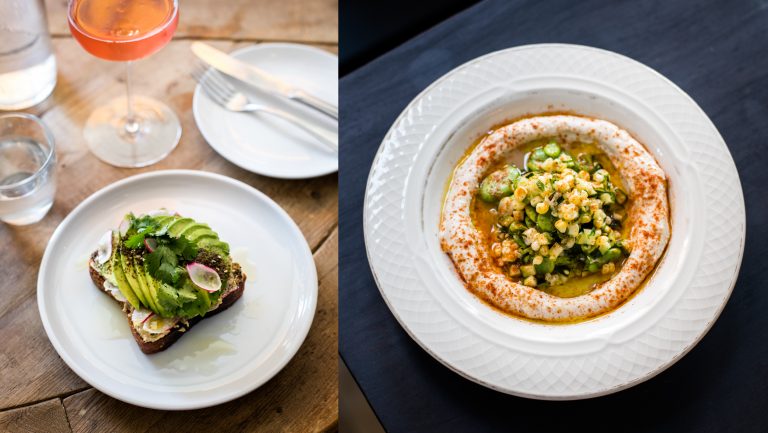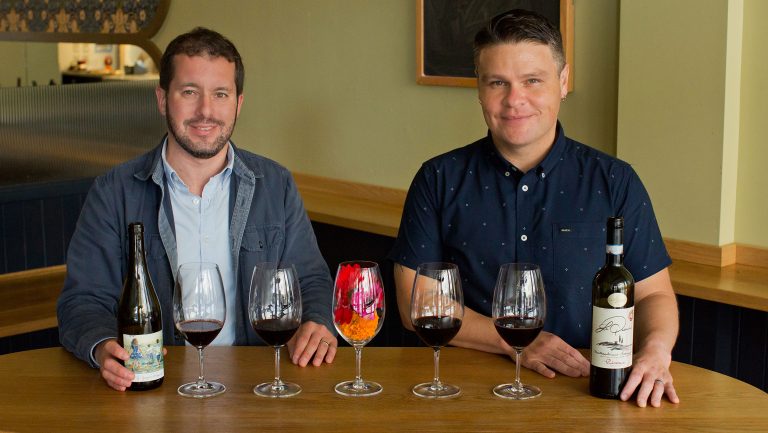Gabriel Stulman, the owner of Happy Cooking Hospitality group, which runs five restaurants in New York’s West Village, has a knack for creating neighborhood places that feel at once sophisticated and at-home relaxed. He’s also proven that he’s not too proud to pivot when a restaurant isn’t quite working, handily reinventing concepts to best fit his audience. The most recent rebirth came to be in July, when Stulman’s team transformed its Italian Perla Cafe into an all-day wine bar of sorts, called Fairfax. It was an insanely fast flip: Perla closed on a Sunday, Fairfax opened the next Thursday.
The tawny banquettes came out, replaced by worn-in leather couches and armed chairs arranged into sitting areas, many with low coffee tables and patterned area rugs. Bookshelves make hidden corners for a massive collection of modern art, potted succulents and fronds, and a brass Castiglioni-style lamp. It becomes very easy to sit back and never put your wine glass down.

The wine list was also overhauled. Now just one page, front and back, Fairfax’s selection is more agile and compact, with an emphasis on by-the-glass options. That wine is to play an important but unfussy role here is reinforced by one particular section of the menu, entitled “Plate + Glass of Wine,” which is offered from 11:30 a.m. until 6:30 p.m. Playing off the French bistro prix-fixe concept, guests can choose a dish and a glass of wine ($15 or less) for the undeniably good, New York City-low price of $20.

Don’t miss the latest drinks industry news and insights. Sign up for our award-winning newsletters and get insider intel, resources, and trends delivered to your inbox every week.
It’s a concept that’s meant to incentivize customers during that questionable midday/early evening timeframe. Why not have a glass with lunch? Meeting a friend for wine at 5? Why not tack on a little snack? The subtle recommendation works. Fairfax moves through 20 cases of glass pours every week.
“It happens pretty frequently that folks come in with the intention of a quick glass and suddenly they’ve got hummus in front of them; suddenly they’re feeling very comfortable and thinking ‘let’s just do dinner here,’” says wine director Nick Grenier (who also oversees the programs at Happy Cooking’s Bar Sardine and Fedora). It’s an easy way to get someone pretty settled into a space, even more so than they were intending to.”
The dishes are shareable and versatile with wine: a burrata set that changes with the market (it’s currently served with marinated mushrooms, capers, and anchovies), same with the white bean hummus (now with cauliflower and pine nuts), simple salads, charcuterie, toasts, a steak tartare.
The wines in the under-$15 range tend to be a bit more adventurous: Hungarian Furmint from Royal Tokaji, deep copper Sangiovese-based rosato from Tuscany’s Moris Farms, Cabernet Franc from Anjou’s Bois-Brinçon. This is Grenier’s attempt to shake his guests out of their usual fallbacks. He goes for wines that are crowd-pleasing in flavor profile, but not necessarily by name. “I like the idea of trying to find that middle ground between what’s going to [put] people a little bit out of their comfort zone without being disorienting.”
This means not having a Sauvignon Blanc, Pinot Grigio, or Cabernet Sauvignon in the under $15 range. “If you have a $14 Sauvignon Blanc, that’s all you sell. Some of the more recognizable things, I might have as our higher-end pours, which tempers it some. I would never have our least expensive glass be something that’s really recognizable. I would never have a $12 Pinot Noir. I’m going to do a $17 or $18 Sauvignon Blanc or Pinot Noir.” He’s been known to pull wines from the by-the-glass list altogether if they’re selling too well.
This strategy requires a certain level of staff education, tasting frequently, giving lots of notes—not always standard practice for by-the-glass picks. “We spend lots of time discussing not just what our Grüner tastes like but what’s your typical expression of Grüner versus ours. It’s this idea of trying to train our staff to understand the defaults and how our selections can be a little unique from that expectation.”
Obviously, there are financial benefits to ordering several cases at a time for the by-the-glass program (his target is $140 to $200 frontline per case for by-the-glass), but Grenier’s not entirely averse to taking single-case drops of wines that are in short supply. “When I come across something that’s cool, a hidden gem, I’ll just roll with it,” he says. “If it lasts me three weeks, great, and if it’s super popular and lasts me a week, that’s fine, too,” he says. The opportunity to show off something that’s from an up-and-coming producer, or an off-the-beaten path bottle, like Château Le Puy’s Duc des Nauves, a naturally made Bordeaux, or Castello di Lispida’s Terralba, an orange Friulano, is worth it.
Now all he has to do is convince New Yorkers to have a glass of wine with lunch. “We’re trying to further cultivate that,” he says.

Dispatch
Sign up for our award-winning newsletter
Don’t miss the latest drinks industry news and insights—delivered to your inbox every week.
Megan Krigbaum is a wine and drinks writer and a contributor to numerous publications. Before going freelance, she was a wine editor at Food & Wine magazine for ten years.







